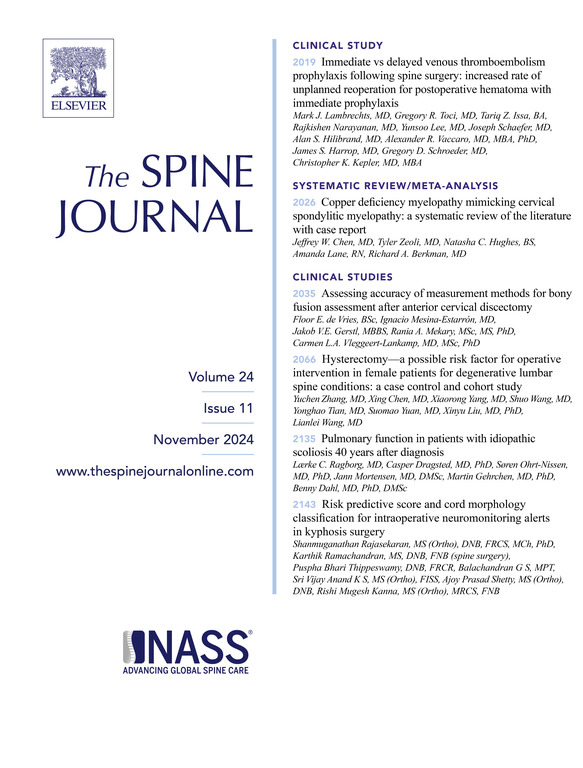Academic and demographic characteristics of spine societies' presidents
IF 4.7
1区 医学
Q1 CLINICAL NEUROLOGY
引用次数: 0
Abstract
There is limited information on spine society presidents' training backgrounds, academic productivity, and demographics. This is crucial because the individuals elected to this role are thought leaders and can impact the future trajectory of spine surgery. The paper characterizes the training backgrounds, academic productivity, and demographics of presidents elected to serve in 7 spine societies: Scoliosis Research Society (SRS), Cervical Spine Research Society (CSRS), North American Spine Society (NASS), Lumbar Spine Research Society (LSRS), International Society for the Study of the Lumbar Spine (ISSLS), American Association of Neurological Surgeons Spine (AANS Spine) and International Society for the Advancement of Spine Surgery (ISASS). This was a retrospective cohort study of 7 spine society presidents (n=156) from 2000 to 2024. The information was retrieved via society websites for the SRS (n=24), CRSR (n=25), NASS (n=25), (n=25), ISSLS (n=25), AANS Spine (n=25), and ISASS (n=23). LSRS provided their list of presidents (n=9) upon request. Training backgrounds, current academic productivity, and demographic characteristics were obtained from online curriculum vitae, academic websites and Scopus. Data collection occurred from June 19, 2024 to September 14, 2024. Most presidents (95.5%) were surgical providers (orthopedic surgeons 106/156, 67.9%; 43/156, 27.6% neurosurgeons). Only 7/156 (4.5%) were nonsurgical providers. CSRS and SRS presidents had the highest cumulative publications and H-index, respectively. The academic rank at appointment was professor for 122/156 (78.2%) presidents. Of the 156 presidents, 12.9% were MD/PhDs. There were 150/156 males (96.2%), and 122/156 were white (78.2%). Spine society presidents are mostly male orthopedic surgeons with high scholarly output. Most had the academic rank of professor. As orthopedic and neurosurgery training programs become more representative of the population, more leaders from diverse backgrounds may become future presidents of these societies.
脊柱学会会长的学术和人口特征。
背景背景:关于脊柱学会会长的培训背景、学术生产力和人口统计数据的信息有限。这是至关重要的,因为被选为这个角色的人是思想领袖,可以影响脊柱外科的未来轨迹。目的:描述七个脊柱学会当选主席的培训背景、学术生产力和人口统计学特征:脊柱侧弯研究学会(SRS)、颈椎研究学会(CSRS)、北美脊柱学会(NASS)、腰椎研究学会(LSRS)、国际腰椎研究学会(ISSLS)、美国脊柱神经外科医师协会(AANS spine)和国际脊柱外科进步学会(ISASS)。研究设计/设置:回顾性队列研究。结果测量:脊柱学会主席的培训背景、学术生产力和人口统计。方法:这是一项回顾性队列研究,涉及2000年至2024年期间的7位脊柱学会主席(n=156)。通过社会网站检索SRS (n=24)、CRSR (n=25)、NASS (n=25)、ISSLS (n=25)、AANS Spine (n=25)和ISASS (n=23)的信息。LSRS应要求提供了他们的校长名单(n=9)。培训背景、当前学术生产力和人口统计学特征从在线简历、学术网站和Scopus中获得。数据收集时间为2024年6月19日至2024年9月14日。结果:院长多为外科医师(95.5%)(骨科106/156,67.9%;43/156, 27.6%神经外科医生)。只有7/156(4.5%)是非手术提供者。CSRS和SRS校长的累积发表量和h指数分别最高。在156名校长中,122名(78.2%)校长的学术等级为教授。在156位校长中,12.9%是医学博士或博士。男性150/156例(96.2%),白人122/156例(78.2%)。结论:脊柱学会会长多为男性骨科医师,学术产出高。大多数人都有教授的学术地位。随着骨科和神经外科培训项目越来越具有代表性,更多来自不同背景的领导人可能成为这些协会未来的主席。
本文章由计算机程序翻译,如有差异,请以英文原文为准。
求助全文
约1分钟内获得全文
求助全文
来源期刊

Spine Journal
医学-临床神经学
CiteScore
8.20
自引率
6.70%
发文量
680
审稿时长
13.1 weeks
期刊介绍:
The Spine Journal, the official journal of the North American Spine Society, is an international and multidisciplinary journal that publishes original, peer-reviewed articles on research and treatment related to the spine and spine care, including basic science and clinical investigations. It is a condition of publication that manuscripts submitted to The Spine Journal have not been published, and will not be simultaneously submitted or published elsewhere. The Spine Journal also publishes major reviews of specific topics by acknowledged authorities, technical notes, teaching editorials, and other special features, Letters to the Editor-in-Chief are encouraged.
 求助内容:
求助内容: 应助结果提醒方式:
应助结果提醒方式:


